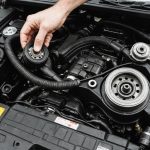Essential Safety Measures for Electrical System Inspections
When conducting an electrical system inspection in hybrid vehicles, understanding the unique risks these systems present is crucial. Hybrid vehicles integrate both traditional engines and electrical components, posing distinct hazards, especially due to high voltage systems.
Personal Protective Equipment (PPE) is vital in ensuring safety. Proper gear such as insulated gloves, safety goggles, and dielectric footwear must always be worn during an inspection. This equipment serves as a first line of defence against potential electrical shocks, which can be severe due to the high-energy systems present in hybrid vehicles.
Additional reading : Step-by-Step Guide: How to Safely Change the Serpentine Belt in Your SUV
Before starting an inspection, it’s essential to implement several key safety precautions:
- Ensure all power sources are deactivated. Disconnect energy storage systems to prevent accidental energisation.
- Verify that warning labels are clearly visible and intact. These labels provide crucial information about potential hazards and the required safety protocols.
- Perform a thorough visual inspection for signs of wear or damage, such as frayed wires or corroded components, which can pose serious risks.
These safety measures not only protect the inspector but also ensure the reliability of the vehicle’s electrical systems post-inspection. By adhering to these protocols, inspectors can minimise risks and maintain the integrity of the operation.
Additional reading : Top Techniques for Assessing Vehicle Frame Integrity Post-Accident: A Comprehensive Guide
Necessary Tools and Equipment for Inspections
When inspecting hybrid vehicles, having the right equipment is crucial. Essential inspection tools include digital multimeters, which are used to measure voltage, amperage, and resistance in the electrical systems. An insulation tester is another vital tool, checking for any faults in the insulation of the electrical equipment, ensuring safety and efficiency.
Diagnostic equipment plays a pivotal role in identifying issues in hybrid vehicles. Scan tools, such as OBD-II scanners, are essential for reading and clearing diagnostic trouble codes. They provide insights into the hybrid vehicle’s health, pinpointing problems quickly. These tools often come with software capable of interpreting complex data, making them indispensable for thorough inspections.
For anyone looking to invest in quality tools, consider reputable brands like Fluke for multimeters and Bosch for scan tools. These brands are known for their reliability and durability in the field of electrical equipment inspection.
Regular updates and maintenance of your diagnostic equipment ensure accuracy, so always check for the latest software and firmware updates from manufacturers. By equipping yourself with these essential tools, you can efficiently and effectively conduct hybrid vehicle inspections.
Step-by-Step Procedures for Conducting an Inspection
Before delving into inspection procedures for hybrid vehicles, a comprehensive understanding of preparation is essential.
Preparation Before Inspection
Begin by gathering necessary tools and equipment to examine electrical systems and mechanisms specific to hybrid vehicles. Ensure the workspace is organised, adequately lit, and free from hazards. Verify that you possess up-to-date inspection procedures guidelines, specifically tailored for the hybrid model at hand. Reviewing the vehicle’s maintenance history can provide insight into any recurrent issues or areas needing meticulous scrutiny. Remember to wear personal protective equipment to safeguard against electric shock during the inspection of electrical components.
Conducting the Inspection
Start by assessing visible elements of the electrical systems such as wiring and connectors for wear and tear. Pay particular attention to the hybrid battery, ensuring it functions optimally and safely. Utilise diagnostic tools to monitor performance metrics and identify any anomalies. When inspecting hybrid vehicles, always follow step-by-step protocols from manufacturers to avoid damaging sensitive components.
Post-Inspection Procedures
Post-inspection, document all findings thoroughly. Include notes on any electrical systems issues or deviations observed, along with recommended action plans. This documentation is not only vital for future repairs but also for ensuring continual operational safety. Additionally, scheduling a follow-up inspection might be necessary if significant repairs are identified, ensuring all potential issues are resolved conclusively.
Common Risks Associated with Hybrid Electrical Systems
Hybrid vehicles offer many benefits, but they also come with electrical risks that require attention. These risks stem primarily from the high-voltage components integral to the vehicle’s operation. Understanding these risks is crucial for both users and technicians.
Overview of Potential Electrical Hazards
Hybrid vehicles utilize a combination of electric and traditional fuel systems. While this improves fuel efficiency and reduces emissions, it introduces specific safety concerns. The high-voltage batteries and electric motors in hybrids can pose a risk of shock and injury, particularly during maintenance or in the event of an accident. Being aware of these hazards is the first step in mitigating them.
Discussion on High-Voltage Components and Their Risks
The core of the electrical risk lies in the high-voltage components. These include the battery pack, electric motor, and associated wiring, running voltages significantly higher than standard vehicles. Improper handling can lead not only to electric shock but also serious burns or fatal injuries. It’s essential for personnel to have proper training and knowledge when managing these parts.
Recommendations for Emergency Procedures
In accidents involving hybrid vehicles, special emergency procedures are necessary. It’s recommended to immediately disconnect the high-voltage battery if safe to do so, to eliminate the likelihood of electric shock. Always keep insulated tools and personal protective equipment at hand for emergencies.
Expert Advice and Industry Standards for Inspections
To ensure the safety and efficiency of hybrid vehicles, adopting best practices in electrical inspections is paramount. Expert tips from industry professionals emphasise the necessity of adhering to established protocols. Certified practitioners highlight the value of conducting comprehensive assessments using advanced diagnostic tools. Ensuring that each inspection is thorough prevents overlooking critical system failures.
In addition to expert recommendations, compliance with industry standards plays a crucial role. These standards, often updated, guide inspectors to maintain uniformity and safety in evaluations. Key regulations are established by authorities like the Society of Automotive Engineers (SAE) and International Organization for Standardization (ISO). Following these guidelines guarantees inspections align with global benchmarks.
Moreover, the automotive industry’s landscape is continuously evolving with technological advancements. Consequently, inspectors must engage in ongoing education and training. This commitment to continuous learning ensures they remain adept at navigating new challenges posed by hybrid vehicles. Institutions and manufacturers frequently offer specialised courses to keep professionals at the forefront of safety compliance.
Balancing expert insights, industry standards, and a dedication to professional development creates a robust framework for conducting reliable electrical inspections. Such a foundation is indispensable for the safety and longevity of hybrid vehicles.











